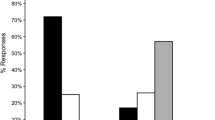Abstract
An empirical study has been carried out to evaluate the potential of word order matching and static comparison as explanatory models of reversal error. Data was collected from 214 undergraduate students who translated a set of additive and multiplicative comparisons expressed in Spanish into algebraic language. In these multiplicative comparisons we used a format that can be translated from Spanish word-for-word as “n times more than” (increasing comparison) and “n times less than” (decreasing comparison) instead of “n times as many”, which is usual in other studies. Data analysis shows a significantly lower incidence of reversal error in the decreasing comparisons compared to the increasing ones. Additionally, no significant differences were found between additive and multiplicative comparisons. These results cannot be explained by the static comparison model.


Similar content being viewed by others
Notes
Contextual clue refers to the possibility of deducing from the relationship described in the statement which quantity should be larger. For example, in the “Students and Professors” problem, on the basis of knowledge from outside the statement, it could be supposed that the number of students would be larger than the number of professors.
Given one cell of this contingency table was zero, the Woolf-Haldane correction was applied.
References
Bell, A., & Malone, J. (1992). Students’ manipulation of algebra symbols and their awareness of the corresponding conceptual relationships. In B. Southwell, B. Perry, & K. Owens (Eds.), Space: The first and final frontier (Proceedings of the 15th Annual Conference of the Mathematics Education Research Group of Australasia) (pp. 120–127). Sydney, Australia: MERGA.
Bell, A., Swan, M., & Taylor, G. (1981). Choice of operations in verbal problems with decimal numbers. Educational Studies in Mathematics, 12(4), 399–420. doi:10.1007/BF00308139
Castro, E. (1995). Niveles de comprensión en problemas verbales de comparación multiplicativa [Levels of comprehension in multiplicative comparison word problems]. Granada: Comares.
Christianson, K., Mestre, J. P., & Luke, S. G. (2012). Practice makes (nearly) perfect: Solving “students-and-professors”-type algebra word problems. Applied Cognitive Psychology, 26(5), 810–822.
Clement, J. J. (1982). Algebra word problem solutions: Thought processes underlying a common misconception. Journal for Research in Mathematics Education, 13(1), 16–30.
Clement, J., Lochhead, J., & Monk, G. (1981). Translation difficulties in learning mathematics. The American Mathematical Monthly, 88(4), 286–290. doi:10.1080/17470211003787619
Clement, J. J., Lochhead, J., & Soloway, E. (1980). Positive effects of computer programming on students’ understanding of variables and equations. In Proceedings of the ACM 1980 Annual Conference (pp. 467–474). Nashville, TN: ACM.
Cohen, E., & Kanim, S. E. (2005). Factors influencing the algebra “reversal error”. American Journal of Physics, 73(11), 1072–1078.
Cooper, M. (1986). The dependence of multiplicative reversal on equation format. Journal of Mathematical Behaviour, 5(2), 115–120.
Fisher, K. M. (1988). The students-and-professors problem revisited. Journal for Research in Mathematics Education, 19(3), 260–262.
Fisher, K. J., Borchert, K., & Bassok, M. (2011). Following the standard form: Effects of equation format on algebraic modeling. Memory & Cognition, 39(3), 502–515. doi:10.3758/s13421-010-0031-6
Hegarty, M., Mayer, R. E., & Monk, C. A. (1995). Comprehension of arithmetic word problems: A comparison of successful and unsuccessful problem solvers. Journal of Educational Psychology, 87(1), 18–32. doi:10.1037/0022-0663.87.1.18
Holm, S. (1979). A simple sequentially rejective multiple test procedure. Scandinavian Journal of Statistics, 6(2), 65–70.
Lewis, A. B., & Mayer, R. E. (1987). Students’ miscomprehension of relational statements in arithmetic word problems. Journal of Educational Psychology, 79(4), 363–371. doi:10.1037/0022-0663.79.4.363
Lopez-Real, F. (1995). How important is the reversal error in algebra? In S. Flavel et al. (Eds.), GALTHA (Proceedings of the 18th Annual Conference of the Mathematics Education Research Group of Australasia) (pp. 390–396). Darwin, Australia: MERGA.
MacGregor, M., & Stacey, K. (1993). Cognitive models underlying students’ formulation of simple linear equations. Journal for Research in Mathematics Education, 24(3), 217–232.
Mestre, J. P. (1988). The role of language comprehension in mathematics and problem solving. In R. R. Cocking & J. P. Mestre (Eds.), Linguistic and cultural influences on learning mathematics (pp. 201–220). Hillsdale, NJ: Lawrence Erlbaum Associates, Inc.
National Council of Teachers of Mathematics. (2000). Principles and standards for school mathematics. Reston, VA: Author.
Nesher, P., Herskovitz, S., & Novotna, J. (2003). Situation model, text base and what else? Factors affecting problem solving. Educational Studies in Mathematics, 52(2), 151–176.
Nesher, P., & Teubal, E. (1975). Verbal cues as an interfering factor in verbal problem solving. Educational Studies in Mathematics, 6(1), 41–51. doi:10.1007/BF00590023
Paige, J., & Simon, H. (1966). Cognitive processes in solving algebra word problems. In B. Kleinmuntz (Ed.), Problem solving: Research, method, and theory (pp. 51–148). New York: Wiley.
Rosnick, P. (1981). Some misconceptions concerning the concept of variable. Mathematics Teacher, 74(6), 418–420.
Van Dijk, T. A., & Kintsch, W. (1983). Strategies of discourse comprehension. New York: Academic.
Verschaffel, L., De Corte, E., & Pauwels, A. (1992). Solving compare problems: An eye-movement test of Lewis and Mayer’s consistency hypothesis. Journal of Educational Psychology, 84(1), 85–94. doi:10.1037/0022-0663.84.1.85
Wollman, W. (1983). Determining the sources of error in a translation from sentence to equation. Journal for Research in Mathematics Education, 14(3), 169–181.
Author information
Authors and Affiliations
Corresponding author
Rights and permissions
About this article
Cite this article
González-Calero, J.A., Arnau, D. & Laserna-Belenguer, B. Influence of additive and multiplicative structure and direction of comparison on the reversal error. Educ Stud Math 89, 133–147 (2015). https://doi.org/10.1007/s10649-015-9596-0
Published:
Issue Date:
DOI: https://doi.org/10.1007/s10649-015-9596-0




